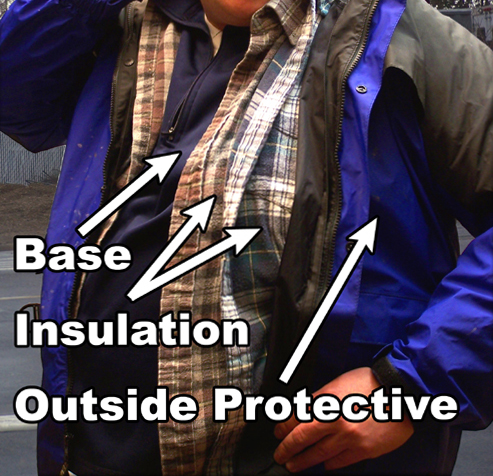Cold Weather Clothing Layers
Use a 3 layer clothing system to maintain a normal body temperature in cold weather conditions. The main goals are to retain heat and stay dry by dispensing and repelling moisture.
 Base Layer: The Base Layer of clothing is right next to your skin and is made from artificial fibers like polyester or nylon. Artificial fiber clothing wicks moisture away from your body, which can otherwise freeze or evaporate, both which make you colder.
Base Layer: The Base Layer of clothing is right next to your skin and is made from artificial fibers like polyester or nylon. Artificial fiber clothing wicks moisture away from your body, which can otherwise freeze or evaporate, both which make you colder.
Cotton underwear and even cotton thermal underwear should not be used because cotton holds moisture next to your body which promotes heat loss through evaporation and conduction.
Insulation Layer: The Insulation Layer of clothing needs to be breathable, like wool or fleece, allowing moisture to vent. Multiple small layers insulate by trapping non-heat conducting air between them. They also have the added benefit of being able to easily self-regulate to a comfortable temperature by adding or removing layers as necessary, rather than one bulky layer.
For shelters, wool or fleece blankets work wonderfully. Store plenty of blankets in your at home emergency supplies. You can never have too many blankets. In a pinch, you can use dry leaves, crumpled paper, or anything else that will trap air layers all around you.
Outside Protective Layer: The Outside Protective Layer of clothing protects against the elements such as wind, rain, snow and sun. Unless you are in an extremely wet environment, water resistant is usually better than water proof because it “breathes” better, letting moisture out.
A protective layer for your shelter, like a tarp, protects you from the ground. A tent also will protect you from other elemental hazards in the surrounding environment. A Mylar tent can reflect your body heat back to you in cold weather and reflect sun and heat away in hot. Any safe structures that block wind, rain or sun can save your life.
An understanding of cold weather clothing layers and the science of effective sheltering will help you to use your available resources to maintain body temperature and make effective, life saving shelters in an emergency situation.
